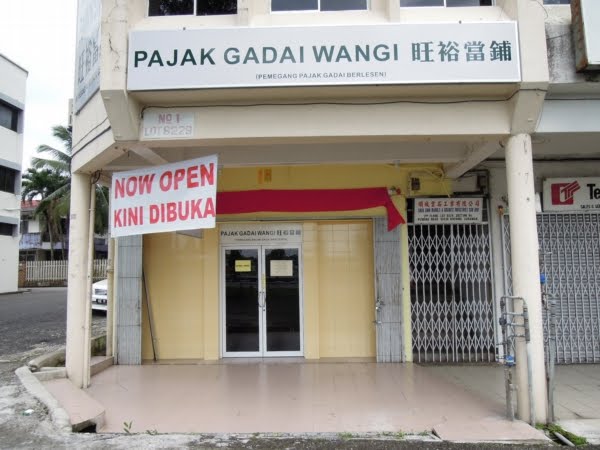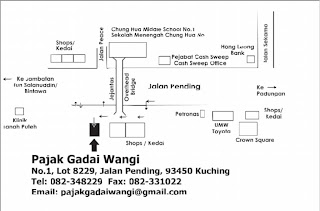Pajak Gadai Wangi accepts platinum, gold, white gold and silver as collateral for a pawn loan.
Interest Rate: 2% per month. Loan Duration: 6 months
(renewable).
Pajak Gadai Wangi menerima platinum, emas kuning, emas
putih dan perak sebagai cagaran untuk pinjaman wang.
Faedah: 2% sebulan. Tempoh: 6 bulan dan boleh dilanjutkan.
旺裕當铺接受铂(Platinum),
黄金, 白金, 银作为抵押。
利息每月2%。贷款期6个月, 可以延长。
|
Read about the different types of Gold.
Difference and comparison: Platinum, White Gold and Silver.
The most common precious metals used for jewellery that are
"silver" in colour are platinum, white gold and silver.
The jewellery industry uses the term "white" for
silver-coloured metals.
Platinum
|
White Gold
|
Silver
|
|
Composition
|
Jewellery platinum is
usually an alloy containing 90% to 95% platinum. Iridium or ruthenium used as
a hardener alloy.
|
White gold is an alloy
of gold and other white metals such as silver and palladium.
White gold is usually
18k (750), 14k or 10k.
|
Sterling Silver (925)
is 92.5% silver and 7.5% copper or other metals.
Copper often used for remaining 7.5% of Sterling silver.
Copper improves the hardness and durability of silver without altering its
colour.
|
Colour
|
Platinum is grey white in
colour and will not fade to yellow like white gold but its shiny finish will
dull to a natural patina over time. It
can be professionally polished to restore its original lustre.
Due to the denseness of
its molecules, platinum shines brighter than any other precious metal.
|
White gold is light
grey and has a hint of yellow.
White gold is more
silvery in colour whereas platinum is more grey.
White gold rings are
usually coated with a hard protective finish of rhodium, a silver-white metal
similar to platinum. The rhodium plating is used to make the white gold look whiter.
|
White-grey coloured.
Silver is the whitest colour metal.
|
Weight
|
Platinum is a very
dense and heavy metal.
Platinum is heavier
than gold and is evident on a large piece of jewellery.
90% Platinum weighs 60%
more than 14K gold.
|
Lighter in weight
(mass) than platinum.
|
Lighter than gold and
platinum.
Lesser quantity
required to create the same piece of jewellery compared to gold or platinum
due to the lighter weight of silver.
|
Hardness
(resistance to
scratching & denting)/
Durability
|
Excellent resistance to corrosion.
The purer the metal, the softer it becomes. Softness means
that the metal sustains scratches easier.
Like all precious metals, pure platinum can be scratched
and dented.
However, platinum does not wear away. The scratch on a
platinum piece is merely a displacement of the metal and none of its volume
is lost.
Platinum loses very little weight during day to day wear
and during polishing.
|
White gold is harder than alloyed platinum and results in
less scratches and dents than platinum.
However, when white gold is scratched, a small amount of
the metal is scratched off and over time, will lead to thinning.
The Rhodium coating on
white gold is very hard but will wear away eventually. White Gold needs to be
re-plated with rhodium from time to time to make it look whiter.
|
Silver is relatively
soft and may be susceptible to scratches or dents
Silver can be easily
filed and polished by jewellers to repair any minor surface damage resulting
from daily wear and tear.
|
Malleability
(How easy a metal bends
and shapes without breaking.)
|
A malleable metal will bend easily, whilst a brittle metal
will not bend easily.
Although platinum prongs are unlikely to break, they can still bend and cause the stone in the settings to become loose. The taller the prongs, the more likely they are to bend with normal daily wear. |
White gold with a
higher content of Palladium is more malleable.
White gold with higher nickel content is not as malleable as white gold with less nickel.
Some diamond jewellery have white gold mountings and prongs as white gold prongs holding diamonds may be more resistant to bending than platinum. |
Silver is more malleable
than any element except gold.
One grain of silver can
be made into a sheet 150 times thinner than a piece of paper.
|
Use in jewellery
|
Commonly used for diamond rings. Platinum is a naturally white metal that does not reflect
colour into the diamond, it is said to enhance the brilliance of diamonds and
other gemstones.
Usually not used in the full range of jewellery products
due to its higher price.
Platinum can’t be re-used and re-melted like white gold.
Therefore, any scraps and filings must be sent to a refiner, adding to the
cost of making platinum jewellery.
|
Widely used in all jewellery.
Precious stones often available in white gold settings.
White gold is one of the
most popular white metal for jewellery due to its cost comparison with
platinum.
Higher quality
palladium alloys of white gold are sometimes not plated. It is not as white in colour as rhodium
plated white gold but does not need to be constantly re-plated.
|
The most popular silver alloy used in jewellery is
Sterling Silver.
Precious gemstones such as diamonds, rubies, emeralds,
etc., are usually not set in sterling silver.
Used more frequently in casual jewellery.
|
Price
|
Very expensive.
Platinum is one of the
rarest metals. Every year only about 90 tons of Platinum is made into
jewellery compared to 2700 tons of gold.
The higher melting
temperature of platinum makes it harder to cast and work with. Therefore,
platinum requires special procedures, chemicals and equipment which add to the
high labour cost of making platinum jewellery.
|
More expensive than
sterling silver.
Labour cost of white
gold jewellery is usually higher than yellow gold jewellery but not as
expensive as platinum jewellery.
|
Least expensive of the
white metals.
|
Ease of Care and
Maintenance
|
Platinum will keep its whiteness unlike white gold.
Pure platinum turns dull much more quickly than white gold
and may develop a greyish-white colour patina due to the surface scratches.
Scratches and other metallic blemish spots can be polished
off.
|
Generally, the harder the metal, the more shine the finish
will show and hold. White gold is harder than platinum; therefore, it holds
its shine longer.
A white gold ring's
rhodium plating subject to wear and tear will need to be recoated every now
and then to maintain the white gold ring’s whiteness.
|
Tarnishes easily.
Silver is also more prone to oxidisation, sometimes
causing the silver to turn black.
Silver jewellery can be easily made to look like new again
with cleaning.
|
Allergy
|
Most jewellery allergy is caused by nickel.
Platinum is purer and
considered to be more hypoallergenic.
|
Nickel is often one of the white metals alloyed with
yellow gold to produce white gold. May cause allergy reaction to people
allergic to Nickel or some of the other metals used as alloys in gold
jewellery.
People with nickel
allergy may opt for nickel-free white gold with higher palladium content.
|
Sterling silver is
often nickel-free.
|



